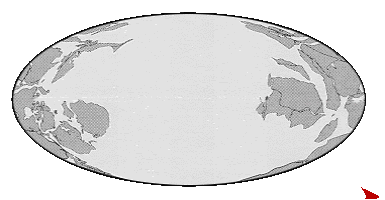We left off the last post with the puzzlement that Modtran looking up and down from the same altitude sees CO2 deviation from the blackbody spectrum, evidence of CO2 absorption and radiance, that matches almost exactly in intensity.

This is illustrated well here from 10 kilometers.

When we zoom in a bit we can see that what is really kissing is the wavenumber 667.4 “spike”. The rotational “shoulders” of the fundamental bending spike are sloped to their respective Planck temperatures. The red upwelling (looking down) shoulders are at 237 K, the lapse temperature for 10 kilometers. This can be found in Modtran by “mouse over” in the lapse graph to the right. The mouse over gives you a pointer dot but no values in the main panel. Using my eyechrometer, I declare that the Planck temperature of the blue downwelling (looking up) shoulders is about 235 K. This corresponds to an altitude about 300 meters higher.
We can summarize that our theoretical spectrometer looking up and down in the CO2 bands at 10 kilometers sees radiation at the blackbody temperature for the altitude of the instrument for the rotational shoulders looking down, but sees the same radiation from a slightly lower temperature and higher altitude than the instrument looking up.The kissing spikes at 667.4 match nearly perfectly.
To get to the bottom of this we need to delve into the rotational shoulders.

This is a HITRAN plot of the absorption fraction in one meter for the CO2 molecule (credit Barret Bellamy). The Q branch, which is almost entirely absorbed within one meter of atmosphere with 380 ppm CO2, is vibrational only and corresponds to wavenumber 667.4. The P and R bands to the left and right represent situations where the 0 to 1 quantum vibrational transition is complicated by part of the energy being diverted to rotation. The P rotations decrease the overall energy of the molecule and the R rotations increase the overall energy. The rotational spectra largely cancel out with a slight net energy increase due to a slightly stronger R branch.
The important point here is this entire spectrum must be viewed as a unit entirely dependent on the fundamental 667.4 “bending” (vibration).

This is what our fundamental 667.4 unit looks like plotted against a bunch of stuff, notably various CO2 spectra seen from space and our 220 K Planck curve. It can be seen that the 667.4 unit defines a gap of zero transmission to the tropopause from the surface, and that this same 667.4 unit (and gap) corresponds to the inclined shoulders of the CO2 spectra the satellites see from space.
With this context, the conundrum we seek to explain is why this 667.4 unit when seen looking down, and inverted looking up, and inclined to the Planck curve; always shows the 667.4 Q branch kissing. This phenomenon is all the more amazing as the Q branch does not appear as a noticeable spike until 10 kilometers at Modtran detail, yet the up and down values for the 667.4 unit match even below 1 kilometer where the upwelling (looking down) CO2 spectra are no different than the Planck curve.
To summarize:

From 1 meter,

to 30 kilometers, the values are ALWAYS equal looking up and down at wavenumber 667.4 for CO2 only. This behavior is unique to CO2 among the main greenhouse gasses.
There is some fundamental limit to the total up and down radiation at 667.4 between the surface and 30 kilometers. My suspicion is this relates to the extraordinarily short (1 meter at surface pressure) extinction path for this wavelength in the 2 good greenhouse gas. Furthermore, since CO2 is a linear molecule with a dipole moment of zero, the zero to one quantum transition at 667.4 is the basis of ALL subsequent vibrational and rotational transitions.

Not only are the rotational shoulders of 667.4 a “unit”, but the entire CO2 spectrum is essentially a unit. Whatever limits 667.4 limits everything else.
While this seems a good start, exactly how this would limit the total up and down radiation seen by Modtran at 667.4 is not clear to me. Perhaps this is a new level of meaning for “saturation”.







Pingback: Modtran Up and Down VI | geosciencebigpicture
Pingback: MODTRAN Up and Down VII | geosciencebigpicture
Pingback: MODTRAN, The One ppm Exercise | geosciencebigpicture